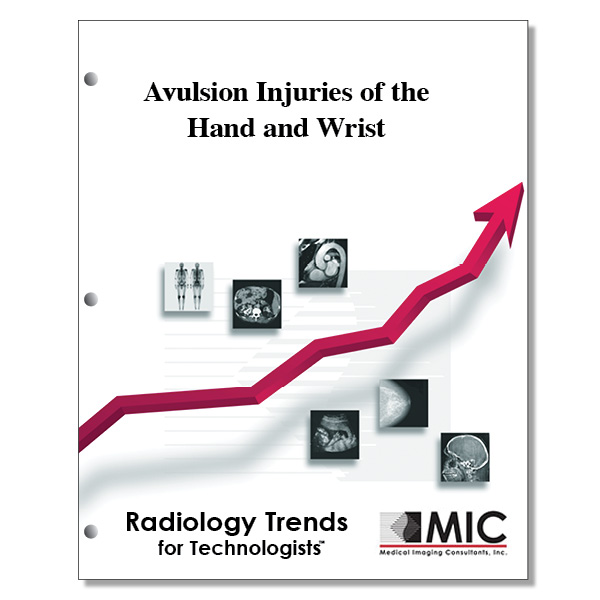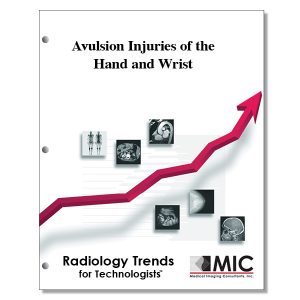

Avulsion Injuries of the Hand and Wrist
A review of the common and uncommon avulsions of the hand and wrist, with a focus on the underlying anatomy and expected radiologic appearance.
Course ID: Q00633 Category: Radiology Trends for Technologists Modality: Radiography2.5 |
Satisfaction Guarantee |
$29.00
- Targeted CE
- Outline
- Objectives
Targeted CE per ARRT’s Discipline, Category, and Subcategory classification:
[Note: Discipline-specific Targeted CE credits may be less than the total Category A credits approved for this course.]
Computed Tomography: 1.50
Procedures: 1.50
Head, Spine, and Musculoskeletal: 1.50
Magnetic Resonance Imaging: 1.50
Procedures: 1.50
Musculoskeletal: 1.50
Radiography: 1.75
Procedures: 1.75
Extremity Procedures: 1.75
Registered Radiologist Assistant: 2.25
Procedures: 2.25
Musculoskeletal and Endocrine Sections: 2.25
Sonography: 1.50
Procedures: 1.50
Superficial Structures and Other Sonographic Procedures: 1.50
Outline
- Introduction
- Trapeziometacarpal Joint Avulsion and Bennett Fracture
- Fifth Metacarpal Bone Fracture: Reverse or Mirrored Bennett Fracture
- UCL Avulsion
- Radial Collateral Ligament Avulsion
- Radial Styloid Process Avulsion
- Ulnar Styloid Process Avulsion
- Mallet Finger
- Central Slip Avulsion
- Jersey Finger
- Ring Avulsion
- Acute Volar Plate Avulsion
- Chronic Volar Plate Avulsion
- Scapholunate Ligament Avulsion
- Triquetral Avulsion Fractures
- Avulsions of the Extensor Carpi Radialis Longus and Brevis
- Related Disorders
- Hydroxyapatite Deposition Disease
- Accessory Ossicles of the Wrist
- Posttraumatic or Reactive Bone Lesions
- Conclusion
Objectives
Upon completion of this course, students will:
- state the prevalence of visits to the emergency department for hand and wrist injuries
- list the mechanisms of injury for hand and wrist injuries
- list the osseous structures of the wrist
- number the joint spaces of the wrist
- describe the primary imaging modality for evaluating healing of hand and wrist injuries
- locate the most common site for a Bennett fracture
- list irreversible sequelae of injuries to the hand and wrist
- discuss how much hand function is provided by the thumb
- state the joint type for the trapeziometacarpal joint
- state the carpal bone most often associated with Bennett fracture
- describe a Robert view of the thumb
- state the treatment options for reverse or mirrored Bennett fracture
- describe the cause of an acute ulnar collateral ligament injury
- state the most common site of ulnar collateral ligament injury
- state the prevalence of radial collateral ligament injuries of the thumb
- list indications for surgical repair of radial collateral ligament injuries of the thumb
- describe the location of the radial styloid process
- list all structures that attach to the ulnar styloid process
- state the most common closed tendon injury seen in athletes
- describe how to radiographically evaluate Mallet finger
- list the long-term complications associated with mallet injuries
- describe how traumatic avulsion of the central slip occurs
- explain how patients present with traumatic avulsion of the central slip
- choose which finger is involved in the majority of jersey finger injuries
- state how imaging modalities assist with assessment of jersey finger
- list the chronic complications of jersey finger
- explain the role of the volar plate
- state the causes of volar plate injuries
- describe the shape of the scapholunate ligament
- list the components of the scapholunate ligament
- describe how scapholunate ligament injuries occur
- state the second most commonly fractured carpal bone
- choose the radiographic projection the demonstrates triquetral fractures as small crescentic or linear bone fragments projecting dorsal to the carpus
- state how many variant ossicles have been described in the wrist
- state the most common symptomatic ossicle of the wrist
